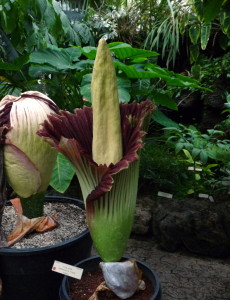
I was treated to a rare, after-hours viewing of this 5-foot-tall “corpse flower” in the Berkeley Botanical Garden in 2009. It lived up to its name, delivering a nauseating stench.
Two months ago, while half the international press corps was on Royal Baby Watch, an equally fervent, if smaller, vigil was underway at the U.S. Botanic Garden in Washington, D.C. This rival watch was not for the birth of a little prince, but for the blooming of one of the garden’s four giant Amorphophallus titanum plants–better known as a “corpse flower,” for the odor it produces on those rare occasions when it blooms: the smell of rotting flesh. Is it disgusting? Totally. Nauseating? Yup. Irresistible? You bet. “People are drawn to this for the same reason they like horror movies,” says Paul Licht, director of the University of California Botanical Garden at Berkeley in California. “We like to feel intense emotions, whether fright or revulsion, as long as we know that we can walk away safely afterward.”
In 2009, Licht treated me to an after-hours viewing of a just-opened corpse flower at the UC Berkeley Botanical Garden (photo above). Of course, he reminded me, the plant doesn’t produce this olfactory extravaganza to supply us with thrills and chills. It does it to attract pollinators–in this case, flies and carrion beetles, which are drawn to the plant as irresistibly as to a dead cow. “This plant can spend decades getting ready to bloom,” he says. “Then it has less than 24 hours to be pollinated.” After that, the flower collapses.
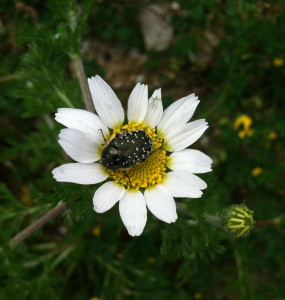 Fortunately for my neighbors, I have no plants that stink of rotting flesh. So how, in one of the nation’s most densely populated areas, paved with concrete, do the flowers in my garden manage to attract butterflies and bees? And why do pollinators visit certain plants, but not others? As it turns out, the clues are all there, if only you know what to look for. When it comes to pollination, says horticulturist and orchid curator Marc Hachadourian of the New York Botanical Garden, “You can read a flower, judging by its shape, color, texture, and smell.” So let’s try:
Fortunately for my neighbors, I have no plants that stink of rotting flesh. So how, in one of the nation’s most densely populated areas, paved with concrete, do the flowers in my garden manage to attract butterflies and bees? And why do pollinators visit certain plants, but not others? As it turns out, the clues are all there, if only you know what to look for. When it comes to pollination, says horticulturist and orchid curator Marc Hachadourian of the New York Botanical Garden, “You can read a flower, judging by its shape, color, texture, and smell.” So let’s try:
What pollinates a daisy? It’s not that hard to find the clues. “Everything you see on a flower is about sex,” says Hachadourian. “It’s a way of saying look at me.” And the daisy is anything but subtle. The petals form a series of rays pointing right to the center. In insect language, this might as well be a flashing neon arrow, guiding insects to the local diner. And there’s easy parking, so to speak, when they arrive. The center of the flower is a flat landing pad–perfect for a rotund, rather clumsy beetle (above), while also accessible to other insects. The result? Rather than attracting a single pollinating species, the daisy can be pollinated by beetles, bees, wasps, and butterflies.
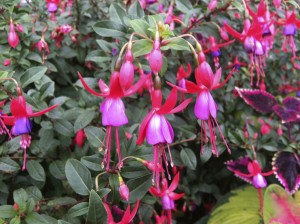 What pollinates fuchsia? At a glance, it’s easy to tell that this flower is too complicated for a simple beetle to navigate. However, its pendulous blossom, with its long tubular “nectary,” is perfect for a hummingbird to dip in its slender, curved bill. Fuchsia makes it easy for the hummers to find their target: The flower’s pistil and stamens dangle alluringly beyond the ends of the petals, forming a series of lines that point toward the center, “like the lights of a runway,” says Hachadourian. And lest there be any mistaking fuchsia’s intent, its brilliant magenta hue is a hummingbird magnet. By the way, the absence of fragrance doesn’t matter a whit. Hummingbirds aren’t drawn to fragrance.
What pollinates fuchsia? At a glance, it’s easy to tell that this flower is too complicated for a simple beetle to navigate. However, its pendulous blossom, with its long tubular “nectary,” is perfect for a hummingbird to dip in its slender, curved bill. Fuchsia makes it easy for the hummers to find their target: The flower’s pistil and stamens dangle alluringly beyond the ends of the petals, forming a series of lines that point toward the center, “like the lights of a runway,” says Hachadourian. And lest there be any mistaking fuchsia’s intent, its brilliant magenta hue is a hummingbird magnet. By the way, the absence of fragrance doesn’t matter a whit. Hummingbirds aren’t drawn to fragrance.
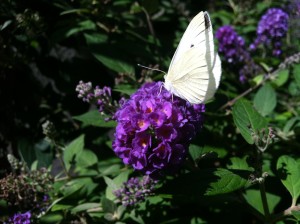 What pollinates a butterfly bush? OK, this is a no-brainer. The name says it all–and my two butterfly bushes have been very popular this summer with cabbage white butterflies, red admirals, and black swallowtails. But they’ve also been regular hives of activity for both bumblebees and honeybees. “Examples of one-plant, one-pollinator are rare,” says Stephen Buchmann, international coordinator of the Pollinator Partnership and co-author of The Forgotten Pollinators. The butterfly bush’s heady scent is a major draw to many insects, so it’s worth what Buchmann calls “a costly investment in advertising” for the plant to produce it. The petals, he says, serve as “scented billboards.”
What pollinates a butterfly bush? OK, this is a no-brainer. The name says it all–and my two butterfly bushes have been very popular this summer with cabbage white butterflies, red admirals, and black swallowtails. But they’ve also been regular hives of activity for both bumblebees and honeybees. “Examples of one-plant, one-pollinator are rare,” says Stephen Buchmann, international coordinator of the Pollinator Partnership and co-author of The Forgotten Pollinators. The butterfly bush’s heady scent is a major draw to many insects, so it’s worth what Buchmann calls “a costly investment in advertising” for the plant to produce it. The petals, he says, serve as “scented billboards.”
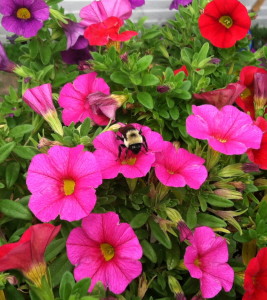 What pollinates a petchoa? This petchoa–a cross between a petunia and calibrachoa–hangs on a railing in my garden. Like petunias, petchoas are pollinated by a variety of insects. They don’t have much of a scent, but with their brilliant colors, that doesn’t seem to matter. For at least five minutes one day, I watched bumblebees flit from one blossom to the next. Each time a bee would land on a blossom, then splay its legs all the way out to the sides of the petals for balance before plunging its head down into the center. How did it know where to find the nectar? I’d never paid attention to this feature of the flowers before. But once I looked closer, it was obvious. The center of each red, pink, or purple blossom is a contrasting bright yellow.
What pollinates a petchoa? This petchoa–a cross between a petunia and calibrachoa–hangs on a railing in my garden. Like petunias, petchoas are pollinated by a variety of insects. They don’t have much of a scent, but with their brilliant colors, that doesn’t seem to matter. For at least five minutes one day, I watched bumblebees flit from one blossom to the next. Each time a bee would land on a blossom, then splay its legs all the way out to the sides of the petals for balance before plunging its head down into the center. How did it know where to find the nectar? I’d never paid attention to this feature of the flowers before. But once I looked closer, it was obvious. The center of each red, pink, or purple blossom is a contrasting bright yellow.
Now, for the advanced test: What pollinates Darwin’s Star Orchid–a rare night-blooming orchid with a 12-inch nectar spur? “Darwin theorized that it was pollinated by a moth with a tongue 12 inches long,” says Hachadourian. It was a logical guess–a moth, because the plant blooms at night when moths are out, and the long tongue, because how else could the moth reach the nectar? By the way, the orchid is white, because it would be pointless for a night-blooming plant to waste energy on producing colors. “The public thought Darwin was mad,” says Hachadourian. “Forty years later he was proven right. With a 4-inch wingspan and footlong tongue, the Xanthopan morganii praedicta hawk moth of Madagascar has the longest tongue relative to body ratio of any animal in the world.”
My flowers and their pollinators may be much more ordinary–garden variety, you might say. But they still fill me with awe. 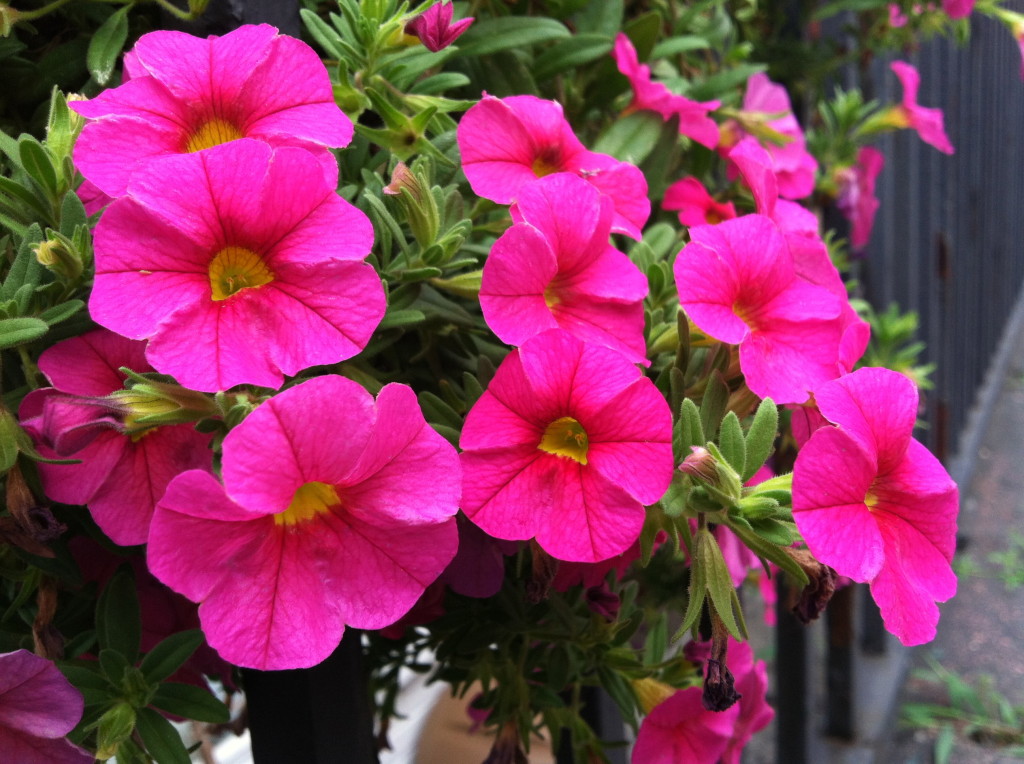

Ha ha! I too saw the Corpse flower at the SF Botanical Gardens in 2009 AND I posted about the DC one blooming on my blog: ofgardens.com. I guess the old saying great minds think alike can be applied here. Nice to meet you at the Garden Blogger’s Conference this weekend!